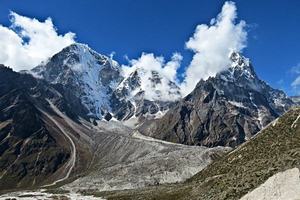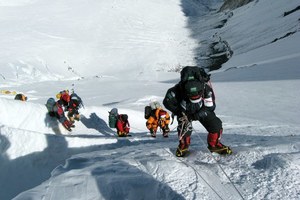This year’s climbing season has seen a rise in the number of deaths on Mount Everest as hundreds of people take on the challenge.
The average deaths per year has remained steady at about 6 for the past 20 years. However, the 2023 climbing season recorded the final count of 18 deaths on the mountain. This is the highest number of deaths since 2015.
Climber’s have been calling for Nepal to limit the number of permits given out to climb Mount Everest per year as overcrowding and a very short window of clear weather caused a ‘traffic jam’ leading up to the summit.
Mount Everest has been an incredible challenge for experienced mountaineers for many years – so what went wrong this year?

Why Are There So Many Mount Everest Deaths Per Year?
There are several reasons why every year a there is a significant number of deaths on Mt. Everest. Here are the biggest factors;
1. Small Window of Opportunity
Each year, there is a very short period of time during which the weather is clear enough to journey up the enormous mountain.
Many climbers began their journey in May. Other natural events and cycles can have a key impact on the climbing conditions over this period the short summiting window.
For example; around the same time over the 2029 season, Cyclon Fani was wreaking havoc in Odisha, India. Everest authorities were worried about the knock-on effects of the cyclone on the mountain and the weather.
The cyclone did indeed affect the weather and mountain activities had to be postponed for a couple of days.
Strong winds caused about 20 tents at Everest Base Camp to blow away and many climber’s who had already began their ascent had to return to camp and wait out the bad weather.
This resulted in crowds of climber’s gathering at the Base Camp. There were only two small windows of clear weather to reach the summit: 19-20 May and 22-24 May. Most teams decided to wait until the second window while a few braved the first.
Due to the number of people trying to reach the summit at the same time, they were all crammed together and clipped onto a single rope line.

2. Poor Management
According to The Sunday Guardian Live a record 478 climbing permits were issued for Everest in 2023 by Nepal authorities. This is already a big, arguably dangerous, increase from the 408 issued in 2021 and 325 in 2022. The number of permits issued contributes to the overcrowding problems on the mountain, which was one of the factors that influenced last year’s Mount Everest death toll.
High climber numbers mean longer queues. The long waiting time on the way up and for the descent, results in exhaustion and low oxygen levels in cylinders.
While Nepal’s regulations require each team to have liaison officers, there is some concern over how strictly this is enforced .
On the busiest summit day of May 2019, only 5 out of the 59 appointed officers stayed with the expedition groups for the whole journey. Most of the officers went home after the delay at the base camp, while others simply did not pitch up at all.
This meant that there were very few officials to manage the crowds and advise the hikers on what the best way forward is. They could have helped split the crowds more evenly between the windows so that the second one wasn’t so overcrowded. This would have lessened the pressure during the second period and made it safer for the climbers.

3. Inexperienced Climbers
Mt Everest towers over the land at a dizzying height of 8,848 meters. This height leads to a number of risks for climbers on the mountain including altitude sickness, freezing temperatures and dangerous routes.
Running out of oxygen is one of the causes of death for climbers on Mt Everest. However, altitude sickness is most common on the Everest Base Camp Trek as it is very difficult to descend to a lower altitude quick enough.
Due to the extremely high altitude, climbers have mere hours to reach the summit before risking pulmonary edema – where the lungs fill with fluid.
Less experienced climbers tend to take longer to get through the ‘death zone’ due to exhaustion and sometimes fear. This year saw a hold up of about 45 minutes as one female climber was ‘frozen with fear’ and could not get down one of the ladders nailed to the cliff face. Another hold up occurred when a group took an hour to navigate one of the Three Steps – a section that would take an experienced climber about 10 minutes. Cause of deaths this year were due to misplaced footing on the ladders or large boulders and sheer physical exhaustion coupled with lack of oxygen.
Competition between tour groups is also a factor contributing to the high number of deaths on the mountain this year as some tour operators failed to check the climbers’ levels of fitness or experience.
There are no regulations about how many people can get permits through Nepal per year and all it takes is a doctor’s note and $11,000 to get one. Experienced climbers have called for Nepal to introduce new criteria for the Mount Everest Permits so that climbers would have had to summitted mountains higher than 6,000 meters before attempting Everest.
The trek up Everest is an incredibly rewarding and unforgettable journey but it is also very dangerous. If you’re interested in taking on Mount Everest, make sure you do thorough research, preparation and training. The Everest Base Camp Trek is suitable for experienced mountaineers and novice hikers alike as it lies at a lower altitude and does not require you to navigate through such dangerous terrain.
Mount Everest Deaths -FAQ
How many people have died on Mount Everest?
According to official records, there have over 330 deaths on Mt. Everest since 1921. There is an average of 4.4 deaths per year but has been significantly higher over the previous decade. In 2023 alone,18 people died during Everest climbing season.
The single deadliest day in Everest's history was on April 25th, 2015. On this date, 19 people were killed at basecamp at a result of a 7.8 magnitude earthquake. Another notable tragedy was in the previous year when 16 Nepali team members were killed by an avalanche on April 14th 2014.
How many dead bodies are on Mount Everest?
Of the approximately 330 people who have died on mount Everest, about 60% of the bodies were not possible to retrieve. This means there are about 200 bodies still on the mountain. Many of the deceased are identified and visible to other trekkers while others have never been found and are likely lost forever.
How many people died on Mount Everest in 2023?
According to the official Himalayan Database, the final count was 18 deaths for the 2023 Everest Climbing season. This makes the 2023 season one of the deadliest yet.
Why aren't bodies recovered from Mt. Everest?
The extreme conditions on Everest and high altitude make it difficult and even dangerous to retrieve the bodies of deceased climbers. A frozen body can weigh around 136kg (300 pounds) and it takes a big team and complex logistics to attempt such a removal. For this reason most bodies on Everest are left where they are.
